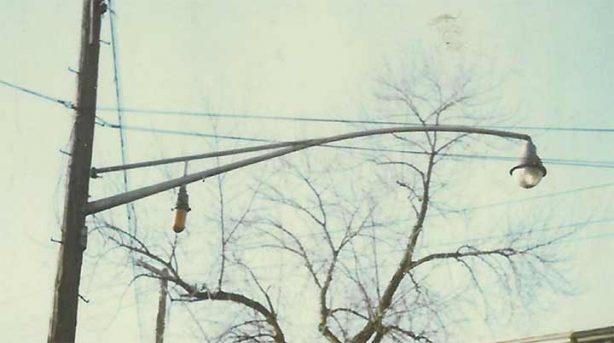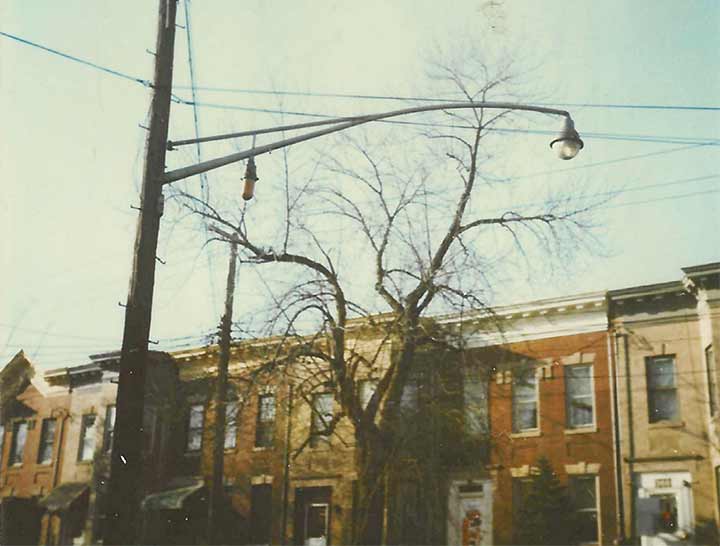
In my now lost youth, I would bicycle all over Brooklyn and Queens from Bay Ridge before bicycling became a religion at whose altar politicians worshiped, creating green bicycle lanes and closing streets. I was on my own on a bike for over 30 years, and other than a few arguments with “doorers,” never met with an accident, since I obeyed traffic signals and lights and yielded to much larger vehicles, pedestrians, dogs and other bicyclists. For me it was the only way to go.

I pedaled all the way out to Cypress Hills and Woodhaven on occasion, on the Brooklyn-Queens border. One day I was following the border, which runs for a few blocks down the center of Eldert Lane. When I reached 95th Avenue I couldn’t believe my eyes. It was a lamppost that I believed long extinct, a telephone pole double-mast with a Westinghouse incandescent cuplight. In addition, this model had the fire alarm indicator lamp appended from the crossbar, common in this particular model.
It was like those fish caught in the Indian Ocean thought from the fossil record to have been extinct for 65 million years, the coelacanth. I had found a living fossil! I first found it in the late 1970s or early 1980s, and on subsequent bicycle trips would diligently check on it. In those years, I had no inkling of a Landmarks Preservation Commission and had I known, I would have intensely lobbied for its preservation. The double mast lasted shortly into the Forgotten NY era, though its fire alarm lamp plastic orange cover dropped off, until it was finally replaced by a regulation short finned mast in 1999 or 2000 with a sodium lamp attached; it since has been converted to LED. Sick transit, Gloria!
Since the lamp was located on the southeast corner, and the Brooklyn-Queens line jogged east on 95th Avenue with the line down the center of the street, the double mast was located in Queens. 95th Avenue is one of the few streets that span three boroughs, Kings, Queens and Nassau. I explain that occurrence on this FNY page.
Photos courtesy Bob Mulero
As always, “comment…as you see fit.” I earn a small payment when you click on any ad on the site.
5/15/23


5 comments
On Little Neck Parkway in the 1950s and 1960s, both sides of Northern Boulevard, there were identical double-mast lamps hung from wooden utility poles. I remember because I lived nearby in those days, and those lamps were quite different from the dark brown Covingtons on Northern Boulevard.
Those are still there, now with LEDs
I remember being pretty startled the first time I saw this light in the late 70’s. At the time there were probably still several hundred incandescent street lights in the city, but they would have been the several dozen cast iron poles scattered around and the lights mounted on elevateds and underpasses. I was baffled by how this light escaped first the mercury conversion of the early 60’s, and the sodium conversion of the early 70’s. The only reason that I can see is that this particular arm could not mount a standard fixture. The picture isn’t clear enough to see if the arm is equipped with a 90 degree fitting to thread into the fixture top, or if the end of the arm is actually bent at 90 degrees. If it is the latter that would explain why it was never converted.
Leaving an incandescent street light like this was an expensive proposition. The standard multiple street light bulb had a life of 3,000 hours. These lamps were meant to be “group relamped” twice a year. By group relamping burnouts were minimized( but not completely eliminated). This means that a bucket trunk had to be dispatched to this location at least twice a year. ( Mercury lamps were group relamped every three years) Also, as you can see from your Welsbach book, this fixture took a 340 or 585 watt incandescent lamp. It was using at least twice the electricity that a a sodium fixture would use.
Also interesting about the photo is that you can see the small rectangular astronomic time switch mounted on the pole about two feet left of the fire alarm light. The mercury fixtures installed in the early 60’s were equipped with photoelectric controls, so over 100,000 astronomic time switches were auctioned off by the City. One surplus dealer on Canal street had these time switches for over twenty years and was selling them for $2.00. He told me he had purchased 20,000 from the City.
There is a telephone pole double mast with a Westinghoue incandescent light at the pedestrian plaza at the Broadway Junction in Brooklyn
Can you be more exact? What streets